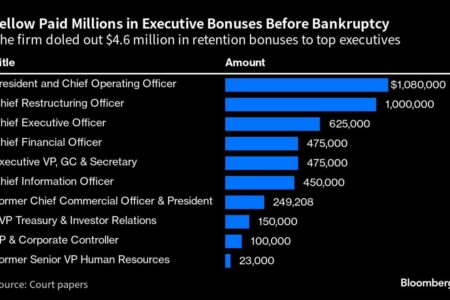(Bloomberg) — Just weeks before closing its doors and dismissing thousands of employees, Yellow Corp. doled out millions of dollars in bonuses to executives so they wouldn’t leave the trucking firm during its chaotic unraveling, court papers show.
Most Read from Bloomberg
Yellow paid bonuses totaling about $4.6 million to eight current and two former executives in the weeks before the company went bankrupt with plans to liquidate, according to corporate disclosures in Delaware bankruptcy court. The figure is higher than it would have been had Yellow managed to avoid a sudden bankruptcy filing, according to a person familiar with the matter.
Of the bonuses disbursed, nearly $2 million paid on July 14 were approved by Yellow’s board in June — when the company was in trouble, but before it was considering filing for bankruptcy, according to the person. Yellow’s public feud with a union representing much of its workforce escalated days later when a strike notice prompted the company’s customers to take their business elsewhere, Yellow has said.
The remaining bonuses paid on July 31 became necessary, then, as Yellow planned for a bankruptcy filing that would be used to repay creditors and wind down, according to the person, who asked not to be named discussing private deliberations. The company’s fleet of trailers, trucking terminals and other assets — all of which would need to be sold quickly and at the highest prices possible — had previously been valued at roughly $2.1 billion. A fire sale could seriously reduce the prices they fetched.
So-called retention bonuses are common in major restructurings, as they incentivize employees to stick around and help clean up failed firms. It’s less common to pay them prior to a bankruptcy filing when, as with Yellow, the company in question is shutting down for good.
The bonuses underscore an unintuitive logic that shows itself time and again when corporations fail: the executives who lead companies to bankruptcy are often the people best equipped to help repay their debts, if only because of the institutional knowledge they possess. Creditors, lower-level employees and even regulators frequently attack retention bonuses as unfair or unnecessary, but federal judges and restructuring advisers routinely find they help creditors hurt by bankruptcy recoup more than they otherwise would.
The July payments include a $1 million retention bonus to Yellow Chief Restructuring Officer Matthew Doheny, $1.08 million to Chief Operating Officer Darrel Harris and $625,000 to Chief Executive Officer Darren Hawkins, according to a company court filing.
Yellow also said it paid retention bonuses totaling roughly $249,000 to its former chief commercial officer and $23,000 to its former senior vice president of human resources. The company paid those bonuses because when it filed bankruptcy it explored the possibility of selling its logistics business as a going concern rather than shutting it down, the person said, but key lenders didn’t support that idea. The bonus payments were therefore used to offset severance payments totaling about $306,000 and $296,000, respectively, the person said.
Yellow didn’t return a message seeking comment. Doheny, Harris and Hawkins didn’t respond to LinkedIn messages seeking comment.
Sean O’Brien, general president of the International Brotherhood of Teamsters, said in a statement that the bonuses should be addressed by Congressional reforms “that workers in this country desperately need.” O’Brien criticized Yellow for making the payments while it skipped paying for employee benefits.
Congress in 2005 restricted companies from paying executive retention bonuses in Chapter 11, prompting companies to pay such awards before filing bankruptcy. There have been calls to curb such pre-bankruptcy bonuses in recent years. In 2021, the Government Accountability Office recommended that Congress require court oversight of executive retention bonuses after more than two hundred executives received around $165 million before their companies filed for bankruptcy.
Disputes over executive pay in bankruptcy court can become particularly heated when a labor union is involved, said Jared Ellias, a Harvard Law School professor who has researched Chapter 11 bonuses. “Given what’s gone on here, I can see why they paid out the bonuses before filing,” Ellias said by phone. Usually, they’re paid without controversy, with court permission, after a liquidation is complete, he said.
Yellow filed bankruptcy on August 6 with $1.2 billion in long-term debt, including a roughly $700 million US government pandemic rescue loan, debt the company said it expects to repay in-full. The shutdown will ultimately leave Yellow’s roughly 30,000 employees jobless, according to a prior company statement.
But the liquidation, now in full swing, has fostered heated competition from lenders and rival trucking companies that see value in Yellow’s assets. Lenders led by Apollo Global Management initially offered to finance the company’s wind-down, a proposal that was eventually supplanted by a better deal with Ken Griffin’s Citadel and hedge fund MFN Partners LP. Since then, Estes Express Lines and Old Dominion Freight Line Inc. have bid against each other for Yellow’s trucking terminals, with Estes most recently offering $1.525 billion.
The case is Yellow Corp. 23-11069, US Bankruptcy Court for the District of Delaware (Wilmington).
(Adds comment from union official in paragraph 10.)
Most Read from Bloomberg Businessweek
©2023 Bloomberg L.P.
